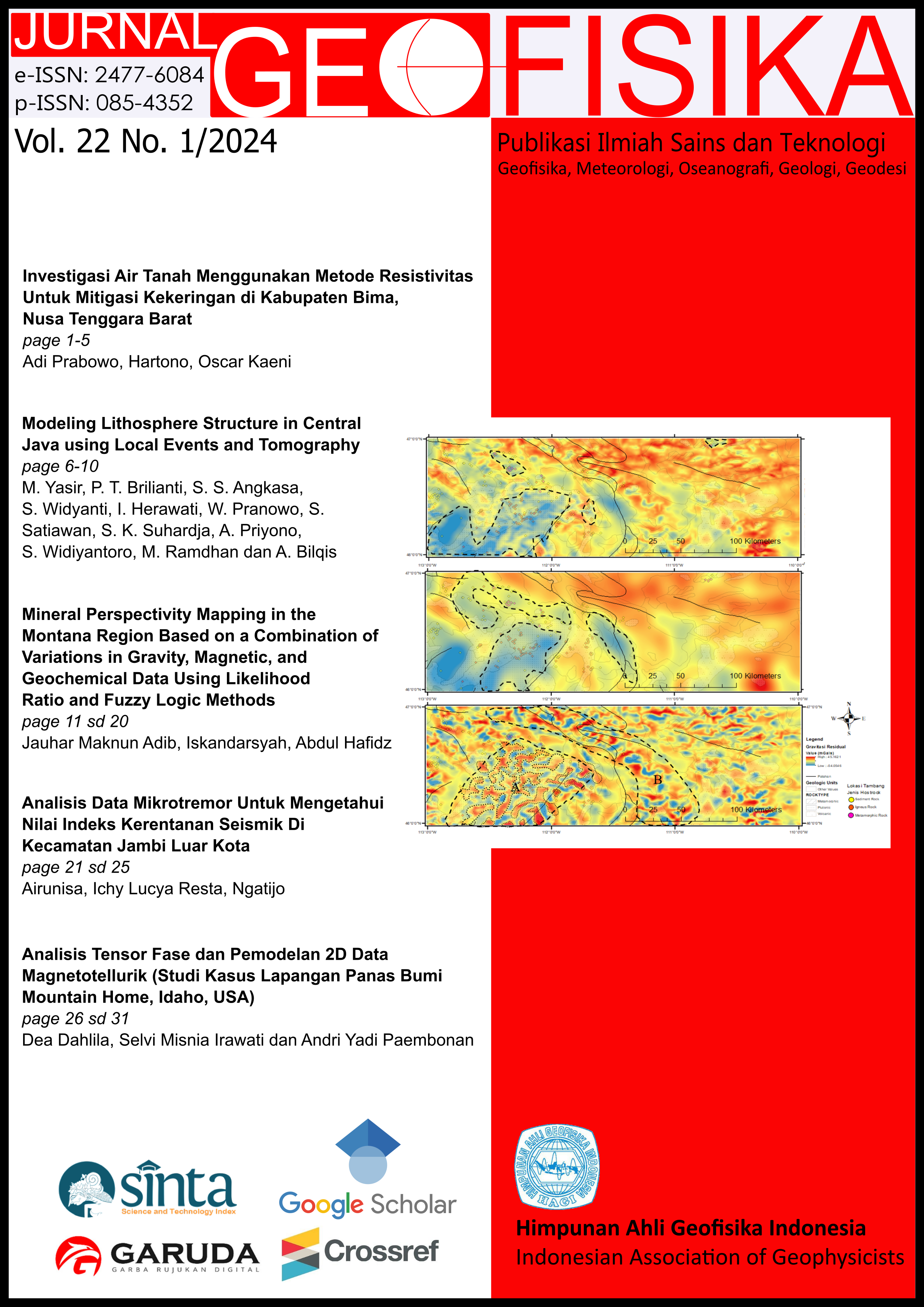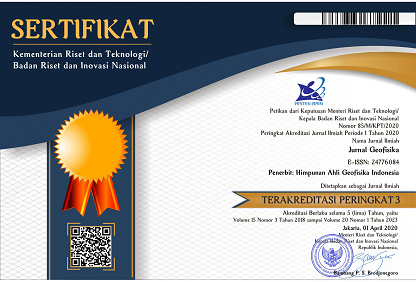Analisis Tensor Fase dan Pemodelan 2D Data Magnetotellurik
(Studi Kasus Lapangan Panas Bumi Mountain Home, Idaho, USA)
Keywords
Dimensionalitas, Magnetotellurik, Panas Bumi, Tensor FaseAbstract
Salah satu metode geofisika untuk mengetahui bawah permukaan bumi adalah metode magnetotellurik yang memanfaatkan sumber alami berupa medan magnet bumi dari medan listrik dan variasi medan magnet. Namun, data yang diperoleh dari lapangan masih dipengaruhi oleh noise atau distorsi yang akan menutupi dimensionalitas sebenarnya dari struktur bawah permukaan, sehingga dapat mengakibatkan kesalahan dalam melakukan interpretasi. Oleh karena itu perlu dilakukan analisis tensor fase untuk mengidentifikasi struktur bawah permukaan yang tidak dipengaruhi distorsi galvanik. Berdasarkan hasil yang diperoleh daerah penelitian memiliki dimensionalitas 2D dengan arah geo-electrical strike N1750E berarah Utara Barat Laut hingga Tenggara. Hasil inversi 2D menunjukkan bahwa resistivitas rendah 1-10 Ωm diidentifikasi sebagai zona alterasi atau clay cap yang berupa batuan sedimen yang berada kedalaman ~1.5 km dimana zona alterasi ini memiliki kemenerusan ke arah timur laut. Pada resistivitas 200-500 Ωm diidentifikasikan sebagai basal berpori. Pada resistivitas 50-70 Ωm diidentifikasikan sebagai riolit yang berasosiasi dengan fluida geotermal.
References
Breckenridge, R., Shervais, J., Nielson, D., & Wood, T. (2012). Exploration and Resource Assesment at Mountain Home Air Force Base, Idaho Using an Integrated Team Approach. Geothermal Resource Council Trans .
Caldwell, T., N.Bibby, H., & Brown, C. (2004). The Magnetotelluric Phase Tensor. Geophysics Journal International , 457-469.
DiPietro, J. A. (2013). Landscape Evolution in The United States An Introduction to the Geography, Geology, and Natural History. Evansville: Department of Geology and Physics, University of Southern Indiana.
Grandis, H. (2014). Metoda Magnetotellurik (MT). Bandung: ITB.
Hughess, S., PH.Wetmore, & JL.Casper. (2002). Evolution of Quartenery tholeiitic basalt eruption centers on the eastern Snake River Plain, Idaho. Idaho Geological Survey Bulletin .
Kessler, J., Bradbury, K., Evans, J., Pulsipher, M., Schmitt, D., J.W.Shevais, et al. (2017). Geology and in situ stress of the MH-2 borehole, Idaho, USA : Insight into wastern Snake River Plain structure from geothermal exploration drilling. 9.
Knott, T., Branney, M., Reichow, M., Finn, D., Coe, R., M.Storey, et al. (2016). Mid-Miocene record of large-scale Snake River-type explosive volcanism and associated subsidence on the Yellowstone hotspot track: The Cassia Formation of Idaho, USA. Geological Society of America Bulletin .
Lewis, R. S., Link, P. K., Stanford, L. R., & Long, S. P. (2012). Geologic Map of Idaho. Idaho: USGS.
Lewis, R., & Stone, M. (1988). Geophydrologic data from a4,403-foot geothermal test hole, Mountain Home Air Force Base. Elmore Country, idaho: U.S Geological Survey.
McCurry, M., & Rodgers, D. (2009). Mass transfer along the Yellowstone hotspot track I: Petrologic constrain on the volume of mantle-derived magma. Journal of volcanology and Geothermal Research .
McCurry, M., Hayden, K., Morse, L., & Mertzman, S. (2008). Genesis of post-hotspot, A-type rhyolite of the Eastern Snake River Plain volcanic field by extreme fractional crystallization of olivine tholeiite. Bulletin of Volcanology .
Morgan, K., & Pierce, L. (1992). The track of the Yellowstone hotsot:Volcanism, faulting, and uplift.
Pierce, K., Morgan, L., & Saltus, R. (2002). Yellowstone plume heard: Postulates tectonic relations to the Vancouver slab, continental boundaries, and climate. Idaho Geological Survey Bulletin .
Rodi, W., & Mackie, R. L. (2001). Nonlinear conjugate gradients algorithm for 2-D magnetotelluric inversion. Society of Exploration Geophysicsts .
Shervais, J. W., Evans, J. P., L.Newell, D., Glen, J. M., Siler, D., DeAngelo, J., et al. (2016). Geothermal Play Fairway Analysis of the Snake River Plain Volcanic Province: Phase 1. Proceedings, 41st Workshoop on Geothermal Reservoir Engineering (hal. 3). California: Stanford University.
Shervais, J., & Vetter, S. (2009). High-K alkali basalt of the western Snake River Plain: Abrupt transition from thoeiitic to midly alkaline plume-derived basalt. Journal of volcanology and Geothermal Reasearch .
Shervais, J., G.Vetter, S, K., S.Hanan, B.B, McGee, et al. (2022). Origin and Evolution of the wastern Snake River Plain : Implications from statigraphy, faulting, and the geochemisthry of basalt near Mountain Home, Idaho.
Shervais, J., Kauffman, J., Gillerman, V., Othberg, K., Vetter, S., VR.Meghan, et al. (2005). Basaltic volcanism of the Central and Western Snake River Plain: A Guide to Field Reations Between Twin Falls and Mountain Home. Boulder Colorado: Geological Society of America.
Telford, W., Geldart, K., & Sheriff, R. (1990). Applied Geophysics, second edition. Press Syndicate of the University of Cambridge.
Vazoff, K. (1991). Magnetotelluric Methode. Electromegnetic Methods in Applied Geophysics Aplication. Society of Explorational Geophysicst.

This work is licensed under a Creative Commons Attribution 4.0 International License.
The copyright of all articles belongs to the authors. All other copyrights is held by the Journal











